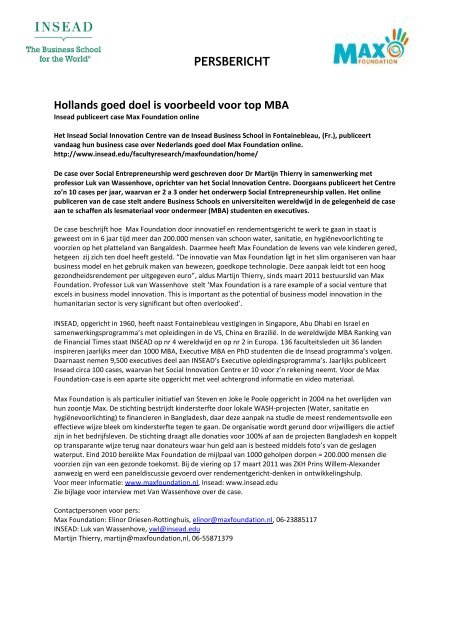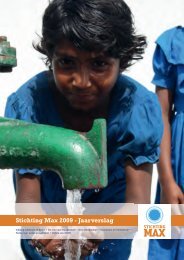PERSBERICHT Hollands goed doel is voorbeeld ... - Max Foundation
PERSBERICHT Hollands goed doel is voorbeeld ... - Max Foundation
PERSBERICHT Hollands goed doel is voorbeeld ... - Max Foundation
You also want an ePaper? Increase the reach of your titles
YUMPU automatically turns print PDFs into web optimized ePapers that Google loves.
<strong>PERSBERICHT</strong><br />
<strong>Hollands</strong> <strong>goed</strong> <strong>doel</strong> <strong>is</strong> <strong>voorbeeld</strong> voor top MBA<br />
Insead publiceert case <strong>Max</strong> <strong>Foundation</strong> online<br />
Het Insead Social Innovation Centre van de Insead Business School in Fontainebleau, (Fr.), publiceert<br />
vandaag hun business case over Nederlands <strong>goed</strong> <strong>doel</strong> <strong>Max</strong> <strong>Foundation</strong> online.<br />
http://www.insead.edu/facultyresearch/maxfoundation/home/<br />
De case over Social Entrepreneurship werd geschreven door Dr Martijn Thierry in samenwerking met<br />
professor Luk van Wassenhove, oprichter van het Social Innovation Centre. Doorgaans publiceert het Centre<br />
zo’n 10 cases per jaar, waarvan er 2 a 3 onder het onderwerp Social Entrepreneurship vallen. Het online<br />
publiceren van de case stelt andere Business Schools en universiteiten wereldwijd in de gelegenheid de case<br />
aan te schaffen als lesmateriaal voor ondermeer (MBA) studenten en executives.<br />
De case beschrijft hoe <strong>Max</strong> <strong>Foundation</strong> door innovatief en rendementsgericht te werk te gaan in staat <strong>is</strong><br />
geweest om in 6 jaar tijd meer dan 200.000 mensen van schoon water, sanitatie, en hygiënevoorlichting te<br />
voorzien op het platteland van Bangaldesh. Daarmee heeft <strong>Max</strong> <strong>Foundation</strong> de levens van vele kinderen gered,<br />
hetgeen zij zich ten <strong>doel</strong> heeft gesteld. “De innovatie van <strong>Max</strong> <strong>Foundation</strong> ligt in het slim organ<strong>is</strong>eren van haar<br />
business model en het gebruik maken van bewezen, <strong>goed</strong>kope technologie. Deze aanpak leidt tot een hoog<br />
gezondheidsrendement per uitgegeven euro”, aldus Martijn Thierry, sinds maart 2011 bestuurslid van <strong>Max</strong><br />
<strong>Foundation</strong>. Professor Luk van Wassenhove stelt ‘<strong>Max</strong> <strong>Foundation</strong> <strong>is</strong> a rare example of a social venture that<br />
excels in business model innovation. Th<strong>is</strong> <strong>is</strong> important as the potential of business model innovation in the<br />
humanitarian sector <strong>is</strong> very significant but often overlooked’.<br />
INSEAD, opgericht in 1960, heeft naast Fontainebleau vestigingen in Singapore, Abu Dhabi en Israel en<br />
samenwerkingsprogramma’s met opleidingen in de VS, China en Brazilië. In de wereldwijde MBA Ranking van<br />
de Financial Times staat INSEAD op nr 4 wereldwijd en op nr 2 in Europa. 136 faculteitsleden uit 36 landen<br />
inspireren jaarlijks meer dan 1000 MBA, Executive MBA en PhD studenten die de Insead programma’s volgen.<br />
Daarnaast nemen 9,500 executives deel aan INSEAD’s Executive opleidingsprogramma’s. Jaarlijks publiceert<br />
Insead circa 100 cases, waarvan het Social Innovation Centre er 10 voor z’n rekening neemt. Voor de <strong>Max</strong><br />
<strong>Foundation</strong>-case <strong>is</strong> een aparte site opgericht met veel achtergrond informatie en video materiaal.<br />
<strong>Max</strong> <strong>Foundation</strong> <strong>is</strong> als particulier initiatief van Steven en Joke le Poole opgericht in 2004 na het overlijden van<br />
hun zoontje <strong>Max</strong>. De stichting bestrijdt kindersterfte door lokale WASH-projecten (Water, sanitatie en<br />
hygiënevoorlichting) te financieren in Bangladesh, daar deze aanpak na studie de meest rendementsvolle een<br />
effectieve wijze bleek om kindersterfte tegen te gaan. De organ<strong>is</strong>atie wordt gerund door vrijwilligers die actief<br />
zijn in het bedrijfsleven. De stichting draagt alle donaties voor 100% af aan de projecten Bangladesh en koppelt<br />
op transparante wijze terug naar donateurs waar hun geld aan <strong>is</strong> besteed middels foto’s van de geslagen<br />
waterput. Eind 2010 bereikte <strong>Max</strong> <strong>Foundation</strong> de mijlpaal van 1000 geholpen dorpen = 200.000 mensen die<br />
voorzien zijn van een gezonde toekomst. Bij de viering op 17 maart 2011 was ZKH Prins Willem-Alexander<br />
aanwezig en werd een paneld<strong>is</strong>cussie gevoerd over rendementgericht-denken in ontwikkelingshulp.<br />
Voor meer informatie: www.maxfoundation.nl, Insead: www.insead.edu<br />
Zie bijlage voor interview met Van Wassenhove over de case.<br />
Contactpersonen voor pers:<br />
<strong>Max</strong> <strong>Foundation</strong>: Elinor Driesen-Rottinghu<strong>is</strong>, elinor@maxfoundation.nl, 06-23885117<br />
INSEAD: Luk van Wassenhove, vwl@insead.edu<br />
Martijn Thierry, martijn@maxfoundation,nl, 06-55871379
<strong>PERSBERICHT</strong><br />
Bijlage: Extract uit een interview met prof. Luk van Wassenhove, ter gelegenheid van de publicatie:<br />
1. How did you identify the need for the case series? E.g. why did you focus on that particular subject,<br />
organ<strong>is</strong>ation, <strong>is</strong>sue or problem?<br />
At INSEAD’s Social Innovation Centre, we are always looking for humanitarian organ<strong>is</strong>ations that are innovative<br />
and from which we can learn something, both academically and in terms of lessons to improve the impact of<br />
humanitarian organ<strong>is</strong>ations in the field. <strong>Max</strong> <strong>Foundation</strong> <strong>is</strong> a rare example of a social venture that excels in<br />
business model innovation. Th<strong>is</strong> <strong>is</strong> important as the potential of business model innovation in the humanitarian<br />
sector <strong>is</strong> very significant but often overlooked. In a period of 5 years, Steven and Joke le Poole, the founders of<br />
<strong>Max</strong> <strong>Foundation</strong>, have created an effective, low-cost, social venture that has delivered clean water and<br />
sanitation to 200,000 people in rural Bangladesh, saving the lives of hundreds of children.<br />
2. Did you encounter any difficulties when writing the case series and/or teaching note, and how were<br />
these overcome?<br />
We had the benefit of a wealth of internal data from <strong>Max</strong> <strong>Foundation</strong>, supplemented by various external<br />
sources. We interviewed all the key people at <strong>Max</strong> <strong>Foundation</strong>. As <strong>Max</strong> <strong>Foundation</strong>’s dec<strong>is</strong>ion making <strong>is</strong> very<br />
much data-driven, we had access to all key materials and supporting data since the start of <strong>Max</strong> <strong>Foundation</strong> in<br />
2005.<br />
3. What are the benefits of presenting the material as a case series?<br />
There are two different cases, which work very well together. Case A highlights how Steven and Joke le Poole,<br />
founders of the <strong>Max</strong> <strong>Foundation</strong>, used business model innovation to create a social venture to maxim<strong>is</strong>e the<br />
(health) return per-euro-spent. The main focus <strong>is</strong> on business model innovation and on identifying innovative<br />
elements in the foundation’s business model can be adopted by other (humanitarian) organ<strong>is</strong>ations.<br />
On March 17 th 2011, HRH Prince Willem-Alexander, Crown Prince of the Netherlands and Chairman of the UN<br />
Secretary General’s Adv<strong>is</strong>ory Board on Water and Sanitation, recogn<strong>is</strong>ed the accompl<strong>is</strong>hments of the <strong>Max</strong><br />
<strong>Foundation</strong> and went on to express the hope that many more people in the developing world would be given<br />
access to clean water and sanitation through its efforts. At th<strong>is</strong> very moment, <strong>Max</strong> <strong>Foundation</strong> <strong>is</strong> considering its<br />
future, contemplating the key strategic dec<strong>is</strong>ions for the next 3 to 5 years.<br />
Case B focuses on these strategic dec<strong>is</strong>ions and examines the challenges and opportunities around up-scaling<br />
strategy, impact measurement, and marketing.<br />
4. What teaching objectives did you hope to sat<strong>is</strong>fy with th<strong>is</strong> case series and were they met?<br />
Case A pursues the following aims:<br />
Familiarizing students with the concept of business models for social ventures and explaining the key<br />
dec<strong>is</strong>ions and activities within the business model<br />
Recogn<strong>is</strong>ing different opportunities for business model innovation by social ventures<br />
Identifying concepts and tools from the business world that can be used in the humanitarian sector,<br />
highlighting potential challenges, and finding solutions to them<br />
Deciding which type of innovation – business model innovation or technological innovation – offers the<br />
highest value for money in the fight against child mortality<br />
Highlighting opportunities for humanitarian organ<strong>is</strong>ations to engage in business model innovation<br />
The <strong>is</strong>sues ra<strong>is</strong>ed in Case B are:<br />
Identifying different ways in which social ventures can scale up and increase their impact<br />
Evaluating different options for scaling up and identifying the implications for the <strong>Max</strong> <strong>Foundation</strong>’s<br />
business model
<strong>PERSBERICHT</strong><br />
Highlighting the importance of impact measurement in the humanitarian sector<br />
Identifying challenges related to impact measurement in the humanitarian sector and solutions to deal with<br />
these challenges<br />
Recogn<strong>is</strong>ing the marketing requirements for humanitarian organ<strong>is</strong>ations<br />
Familiarizing students with the development of a marketing strategy for a specific donor segment<br />
Teaching objectives are very much met in that th<strong>is</strong> suite of cases <strong>is</strong> richly documented with a lot of<br />
supplementary materials (videos, articles, slide sets) and can be used for virtually all types of audiences from<br />
undergraduates to MBAs and executives, and not in the least for programs with participants from NGOs or<br />
social entrepreneurs. It <strong>is</strong> sufficiently flexible to be used in different ways, from a short class (using only case A<br />
or case B) to a series of classes injecting supplementary materials.<br />
5. How do you env<strong>is</strong>age that th<strong>is</strong> case series could be used by colleagues in other organ<strong>is</strong>ations?<br />
The case can be taught in various courses related to social impact, including courses on non-profit and NGO<br />
management, policy making, international health care, and social entrepreneurship. It also covers topics<br />
relevant to classes on strategy, organ<strong>is</strong>ational behaviour and marketing. The case <strong>is</strong> particularly suitable for use<br />
as an integrative and inter-d<strong>is</strong>ciplinary exerc<strong>is</strong>e, bringing together the perspectives of different groups.<br />
In addition, it can be taught in courses outside the domain of social impact, particularly those related to<br />
business model innovation, organ<strong>is</strong>ational learning, and entrepreneurship. It <strong>is</strong> suitable for undergraduate,<br />
graduate, and executive audiences.<br />
Fontainebleau, October 2011



